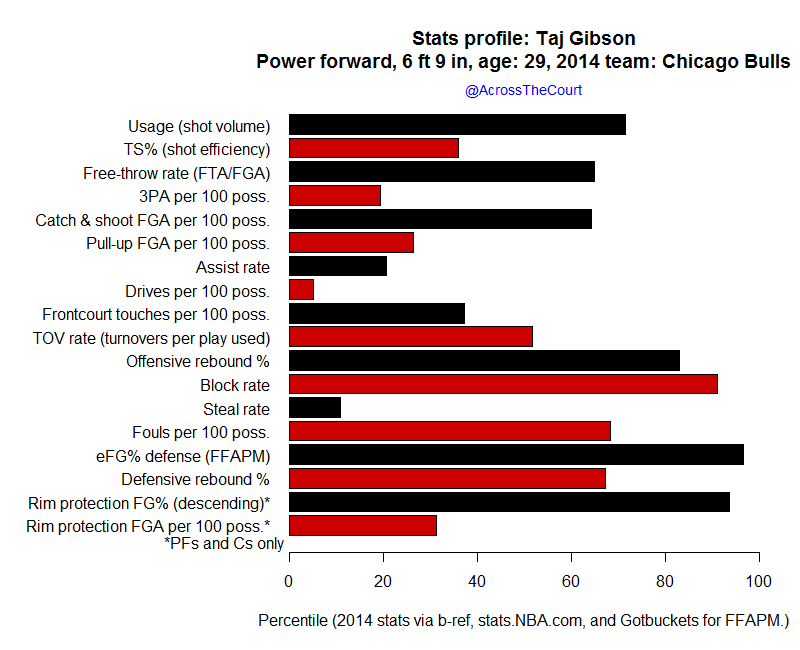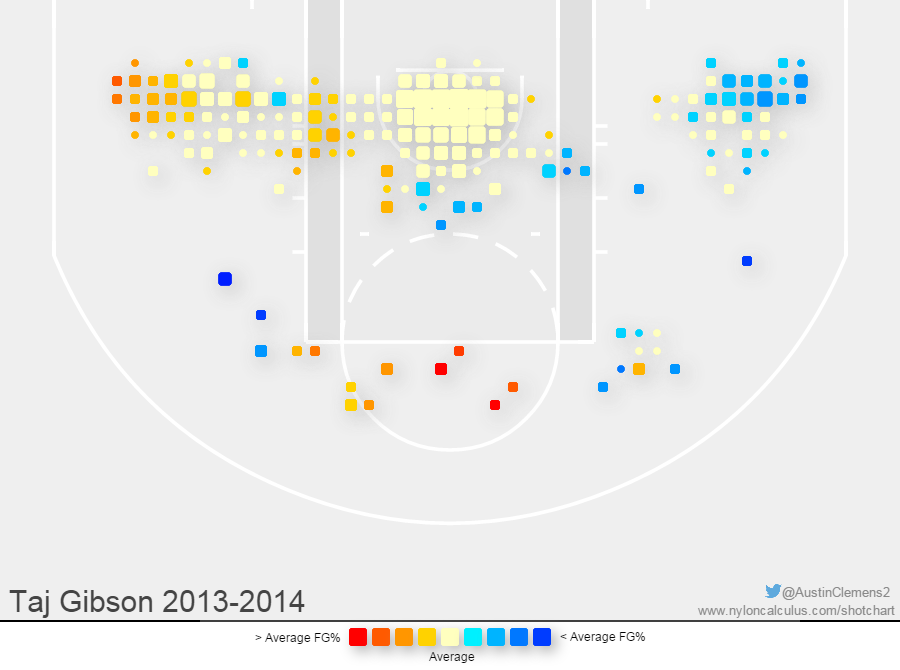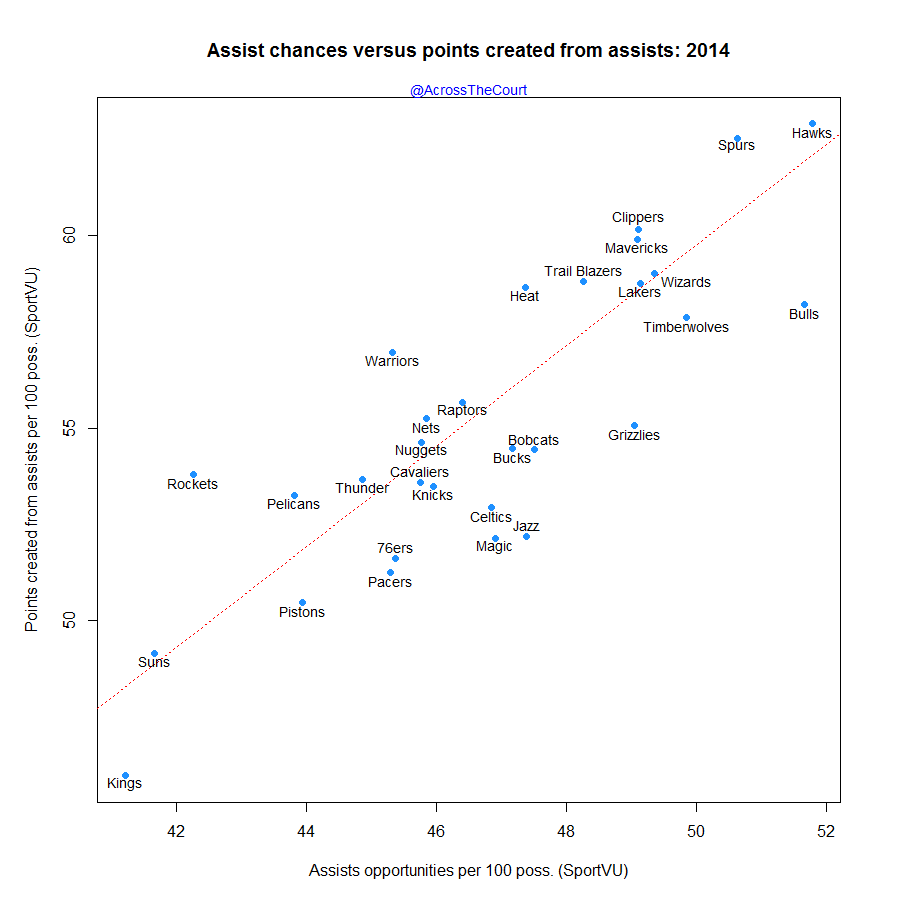Cautious optimism: welcome to the 2015 season for the Chicago Bulls. After a few years of waiting for Rose to come back, it may finally be time. With the lack of contending teams in the east, the basketball world needs them to be competitive for pure symmetry and for a more exciting set of playoff series. But I would warn anyone against excessive optimism here and any idea of Chicago as a “lock” for the number one seed or as the more likely team to reach the finals is going too far. Rose, after all, hasn’t been healthy in the playoffs for three straight years — let’s not go overboard here.
2014 in review
Derrick Rose’s return was highly anticipated and while he had the kind of athleticism to wow crowds again, he basically looked rusty. It’s one thing to miss a few jump shots; it’s another to blow shots at the rim. Any rust wasn’t surprising, but he lasted only 10 games — he was out for the season with a torn meniscus, leading to surgery. At least it was a surgery to repair the meniscus, not remove it, as Wade had done years earlier in college. Westbrook, for example, was as good as ever last season, and he’s one of a very select few athletes who can compare with him stylistically and athletically.
But enough injury talk: this was a Thibodeau squad and as expected they did not tank the season nor did they stop defending. Even with players like Dunleavy, Boozer, and Augustin in the rotation, they finished with the second best defensive rating in the league, limiting their effectiveness when shooting while rarely fouling. They goad opponents into taking long two-pointers, even giving up wide-open shots, so they can contest shots inside and chase guys off the three-point line. Their system is taxing, and on offense the same kind of grit is used to squeeze out a few more points with ball movement and passing. Joakim Noah epitomized the club as much as any one player could and had what could be his best season ever. He was healthy, missing only two games, while deservedly winning the Defensive Player of the Year award and becoming one of a rare set of centers who averaged at least 5 assists a game along with Kareem, Alvan Adams, Wilt, Divac, Sam Lacey, Jeff Ruland, Bill Russell, Unseld, and Walton. But without Rose, too many of those carefully constructed plays dissipated in the hands of lesser players. The Bulls were last in the league in shooting efficiency (eFG%) with a high turnover rate. They were a little lucky to win 48 wins, thanks partially to a weak conference and thus a weak schedule. They were defeated unceremoniously in five games by Washington in the first round even with homecourt advantage. We root for the underdogs in stories, but real life isn’t as kind as Hollywood.
Changes
Exit: Carlos Boozer, D.J. Augustin, Luol Deng, Marquis Teague, Mike James, Erik Murphy, Jimmer Fredette, Cartier Martin, Tornike Shengelia, Jarvis Varnado, Lou Amundson.
Enter: Pau Gasol, Nikola Mirotic, Aaron Brooks, Doug McDermott, E’Twaun Moore.
I imagine Taj Gibson must be ambivalent right now. Carlos Boozer is finally gone and just as a promotion to the starting lineup is imminent, the Bulls bring in Pau Gasol, not to mention Mirotic on the bench eating up some forward minutes. Sadly, they also got rid of Luol Deng by shipping him off to what was a basketball wasteland at the time, Cleveland. Replacing some of the small forward minutes still vacant will be Doug McDermott, who confounded draft models with an absurdly low steal rate and other athleticism indicators. Aaron Brooks is the latest point guard reclamation project after D.J. Augustin, Hinrich, and Nate Robinson.
Player spotlight
Defense may forever remain underrated in the world of the NBA and sports in general. There were few better examples of this phenomenon than last season when Jamal Crawford again won the Sixth Man of the Year award. Taj Gibson was in second-place, but based on his production and how well the Bulls play with him he was deserving of an award. Via the bar chart below, he actually increased his usage rate by a significant amount; he was well above average. His efficiency, however, is usually around the 30th percentile or lower. One reason for his low efficiency is his reliance on midrange jumpers. (Don’t be fooled by his non-zero percentile in three-pointers: since so many guys aren’t outside shooters, taking only 7 attempts can put you in the 20th percentile.) He’s fairly active on the offensive glass, however, and like his teammate Noah he’s one of the best screeners in the league.
Taj’s real value is derived on the defensive end. He’s a very good shotblocker for a power forward, and opponents shoot a low percentage at the rim when he’s nearby. He doesn’t guard too many attempts at the rim, however; perhaps this is due to his role in guarding smaller players for Noah or Mohammed. He generates few steals, but he’s one of the best in the eFG% defense category; most plus/minus metrics love him on defense and have for years.
Gibson’s shooting behavior is pretty stable. He takes a large number of shots inside, of course, but he’s a highly frequent baseline jump shooter with a few stray shots at the top of the key. Generally, his efficiency is usually average or below average, and he’s best inside where he’s merely average to slightly above average. The biggest change last season was an expanded use of his low-post game, which you can see on the left block.
For a visual of his actual offense, there’s a playlist below versus the stout Oklahoma City defense. In the first video, Taj completes an odd three-point play after hitting a free throw and then missing the second one: he dives to the rim when the ball goes to Boozer, receives it, and then pivots around for a short hook shot. Matching up against Ibaka in the second video, Taj muscles his way inside and spins with his back on the defender for a layup. Against the more physical and stronger Kendrick Perkins, he faces him up and then just blows past him off the bounce and under the backboard for a reverse lay-in. Then versus a third defender, Collison, in the fourth clip, he hits a turnaround jump shot in his preferred baseline area. In the last video, he scores when Augustin draws attention on a drive and passes it right back to Gibson under the rim. The second playlist has an example of his typical midrange jump shot. He has a high release and with his long wingspan he’s hard to block.
One of the best examples of Gibson’s defense was a game versus the low-post happy Grizzlies. Matched-up against Zach Randolph in the first video, he stalks the Grizzly all the way to the rim and rejects his attempt. Gibson’s value as a rim protector is apparent in the second video. With Noah on the perimeter, Gibson is the one hanging back at the rim and swatting a shot by Bayless away. Centers aren’t immune either, as Koufos found out in the third video. When both Noah and Gibson are on the court, shots inside are awfully difficult to manage: both defenders are always locked in and keeping an eye on the paint, as you can see in the fourth video. Lastly, if trying to score on him, as Davis does in the fifth video, posting him up is probably the least effective way due to his strength, long arms, and timing.
The Bulls have an embarrassment of riches in the frontcourt now. Gibson isn’t a well-known player like Pau, but he’s long been of the most valuable bench players and the team’s most successful lineups will probably feature him in a large portion of them. He has an expanded low-post game too and carried a larger offensive burden last season. With some more firepower around him, his shooting efficiency should increase with easier opportunities at the basket after setting screens.
2015 projected
Never get so attached to a poem,
You forget truth that lacks lyricism.
-Newsom
Chicago might be bringing back Rose, but that doesn’t mean the most likely scenario is 2011. The team has greatly changed since then and it’s not as simple as “Rose+Bulls=60 wins” as some lead you believe. This is the same team that last season was one of the worst on offense with only the Magic and 76ers rating poorer. The return is nearly mythic and expectations are high, but it’s best to temper the excitement. Reality is dirtier.
There’s no clear understanding of how good Rose will be. After looking rust-covered last season and during the FIBA tournament, he’s finally hitting his shots from both inside and outside the arc. In eight preseason games, he’s at 27 points per 36 minutes with an outstanding 60.5 TS%. Obviously, percentages can fluctuate in a small set of games, but it’s an encouraging sign. The question now is how much of his former glory can he recover? As a conservative estimate, I’ve reduced the value he had at his peak in 2011 and 2012 in terms of what he adds per 100 possessions by 75%. Since the only case like Rose is himself, there’s no way to scientifically quantify this. (My minutes are a little more conservative than the other projections I’ve seen, and my skepticism served me well last year.)
Though there’s another player for whom a rating is difficult to estimate. Pau Gasol was a big target in free agency, but it’s not based on his play the last two seasons. He’s been jogging around like a mummy lately in the NBA, and he made waves neither on offense or defense. He was substantially better in FIBA, however, and with his size and high skill-level there’s a reasonable expectation that in a better system and with better teammates he can recapture some of his value. I would be hesitant assigning some high, all-star like value to him, but even if he’s neutral it’s still a hefty improvement over Carlos Boozer. Most people know the latter for bad defense, but his offense was actually horrendous since he shot a low percentage, created few plays for others, and Chicago usually played better without him.
There’s another issue with bringing in Pau: their frontcourt was already a strength and they’re stacking where they need it the least. Noah’s the one everyone knows, a sort of poor man’s Bill Walton with high activity on defense and on the boards with exceptional passing from the high post. Taj Gibson is still underrated — the player spotlight covers this. Then there’s Mirotic who will receive most of his minutes at power forward. The international import has been one of Europe’s best players for years. He’s an efficient scorer with three-point range and has been one of Real Madrid’s — one of the top teams in the most competitive league outside the NBA — best players for a while. He’s still only 23 years-old.
(A technical note on Noah and Taj Gibson’s defensive plus/minus through the years: no metric is without its flaws and RAPM has been sour on Noah for a while. Even with some advanced statistical techniques, some issues cannot be solved well. Back when Chicago’s defense was at its best, Noah was starting with the near-liability Boozer while the excellent Taj Gibson and Omer Asik came off the bench. Since Noah played a lot more with Boozer, the RAPM models didn’t have enough information to assign the appropriate amount of defensive value to each player. That may have been the problem. For an example of how well Noah rates on defense compared to Taj, let’s turn to NBAWOWY.com and make this a fair fight. In 1048 minutes over the past two seasons with Gibson and Boozer on the court, the Bulls surrendered 106.9 points per 100 possessions — a league average rate — with opponents shooting 64% inside of 3 feet. By comparison, with Noah and Boozer in 3596 minutes they gave up 103.2 points per 100 possessions shooting 60.7% inside.)
At small forward, the Bulls have a little more offensive firepower. Mike Dunleavy played surprisingly well in their system, and his passing and shooting skills will be better utilized with Rose in the lineup. Tony Snell is being molded into their next Luol Deng as a long, defensively-minded small forward, but he has a ways to go before his production-level warrants heavy minutes. McDermott’s an intriguing draft pick that polarized traditional scouts and advanced stats. He has no peers when it comes to his low steal totals, which usually indicate a lack of athleticism and elite awareness, as no one who’s ever played in the league has ever had totals that low. Another negative was his low assist to turnover ratio, an important stat for translation. Watching him in preseason and from what the team has said about him, he does clearly have offensive skill and has appeared like an NBA player. However, his preseason stats were mostly disappointing. He had two blocks and one steal total, naturally, but it’s unclear if his low shooting percentages will hold with a larger set of games. Will he be the next Adam Morrison or the next Wally Szczerbiak?
If Rose can’t play full-time, cagey guard Hinrich and the tiny point guard Aaron Brooks will try to steer the ship. Hinrich is still pretty good on defense, but you do not want him running your offense. Brooks somehow scored 19.6 points a game in 2010, which seems like an eon ago. Now he’s a short, scoring point guard who’s lost his scoring punch and is entertaining his 30’s when he has always been a defensive liability. This will be Thibodeau’s greatest test yet. What’s interesting about the Bulls is that even without high-level point guard support they’re still a pass-heavy team. Via the graph below, the Bulls are an assist happy squad virtually tied with the Hawks in creating the most assist opportunities. However, given the distance they are from the red line (league average) they are the poorest in the league at translating assist opportunities into points. This might indicate that some real offensive weapons will be better utilized in their system.
Summary
With the collapse of the Indiana Pacers, the Bulls have a strong chance for the best defensive rating in the league and with some competent players on offense they would be a solid team with a win total in the 50’s. Exuberance on the part of Rose’s return should be managed here, however; it would be unwise to assume it’s 2011 all over again. But in the broken empire of the eastern conference, we need them now more than ever.
Wins: 55
Losses: 27
Conference rank: 2nd
League offense rank: 16th
League defense rank: 1st
Edited 10/27/14























